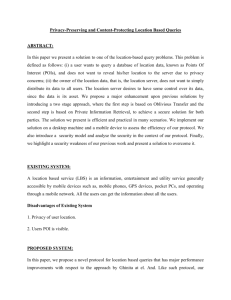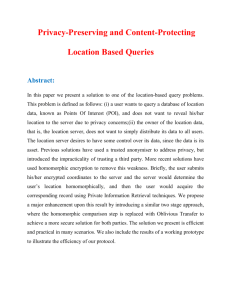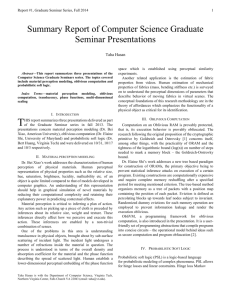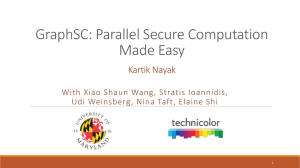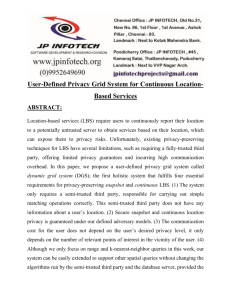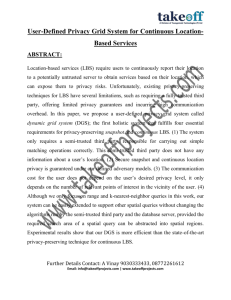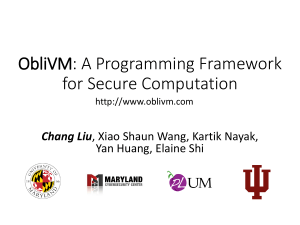- Krest Technology
advertisement
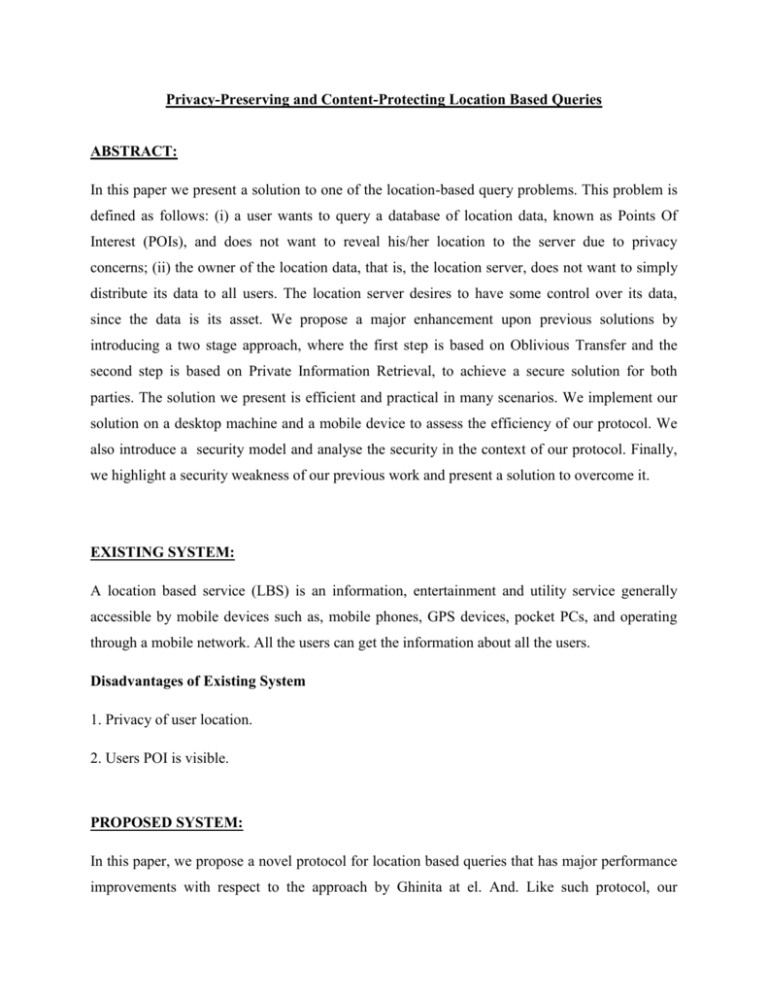
Privacy-Preserving and Content-Protecting Location Based Queries ABSTRACT: In this paper we present a solution to one of the location-based query problems. This problem is defined as follows: (i) a user wants to query a database of location data, known as Points Of Interest (POIs), and does not want to reveal his/her location to the server due to privacy concerns; (ii) the owner of the location data, that is, the location server, does not want to simply distribute its data to all users. The location server desires to have some control over its data, since the data is its asset. We propose a major enhancement upon previous solutions by introducing a two stage approach, where the first step is based on Oblivious Transfer and the second step is based on Private Information Retrieval, to achieve a secure solution for both parties. The solution we present is efficient and practical in many scenarios. We implement our solution on a desktop machine and a mobile device to assess the efficiency of our protocol. We also introduce a security model and analyse the security in the context of our protocol. Finally, we highlight a security weakness of our previous work and present a solution to overcome it. EXISTING SYSTEM: A location based service (LBS) is an information, entertainment and utility service generally accessible by mobile devices such as, mobile phones, GPS devices, pocket PCs, and operating through a mobile network. All the users can get the information about all the users. Disadvantages of Existing System 1. Privacy of user location. 2. Users POI is visible. PROPOSED SYSTEM: In this paper, we propose a novel protocol for location based queries that has major performance improvements with respect to the approach by Ghinita at el. And. Like such protocol, our protocol is organized according to two stages. In the first stage, the user privately determines his/her location within a public grid, using oblivious transfer. This data contains both the ID and associated symmetric key for the block of data in the private grid. In the second stage, the user executes a communicational efficient PIR, to retrieve the appropriate block in the private grid. This block is decrypted using the symmetric key obtained in the previous stage. Our protocol thus provides protection for both the user and the server. The user is protected because the server is unable to determine his/her location. Similarly, the server’s data is protected since a malicious user can only decrypt the block of data obtained by PIR with the encryption key acquired in the previous stage. In other words, users cannot gain any more data than what they have paid for. We remark that this paper is an enhancement of a previous work. ADVANTAGES OF PROPOSED SYSTEM: Redesigned the key structure. Added a formal security model. Implemented the solution on both a mobile device and desktop machine. SYSTEM ARCHITECTURE: 5.1 Modules 1. User 2. Oblivious Transfer Phase 3. Private Information Retrieval Phase 4. Location Server User The ultimate goal of our protocol is to obtain a set (block) of POI records from the LS, which are close to the user’s position, without compromising the privacy of the user or the data stored at the server. We achieve this by applying a two stage approach shown in fig. The first stage is based on a two-dimensional oblivious transfer and the second stage is based on a communicationally efficient PIR. The oblivious transfer based protocol is used by the user to obtain the cell ID, where the user is located, and the corresponding symmetric key. The knowledge of the cell ID and the symmetric key is then used in the PIR based protocol to obtain and decrypt the location data. The user determines his/her location within a publicly generated grid P by using his/her GPS coordinates and forms an oblivious transfer query. The minimum dimensions of the public grid are defined by the server and are made available to all users of the system. Oblivious Transfer Phase The purpose of this protocol is for the user to obtain one and only one record from the cell in the public grid P, We achieve this by constructing a 2-dimensional oblivious transfer, based on the ElGamal oblivious transfer, using adaptive oblivious transfer proposed by Naoret al. We remark that this key structure of this form is an enhancement from, as the client doesn’t have access to the individual components of the key. Private Information Retrieval Phase With the knowledge about which cells are contained in the private grid, and the knowledge of the key that encrypts the data in the cell, the user can initiate a private information retrieval protocol with the location server to acquire the encrypted POI data. Assuming the server has initialized the integer e, the user ui and LS can engage in the following private information retrieval protocol using the IDQi,j , obtained from the execution of the previous protocol, as input. The IDQi,j allows the user to choose the associated prime number power πi, which in turn allows the user to query the server. Location Server The Location Server (LS), which offers some LBS, spends its resources to compile information about various interesting POIs. Hence, it is expected that the LS would not disclose any information without fees. Therefore the LBS have to ensure that LS’s data is not accessed by any unauthorized user. During the process of transmission the users should not be allowed to discover any information for which they have not paid. It is thus crucial that solutions be devised that address the privacy of the users issuing queries, but also prevent users from accessing content to which they do not have authorization. SYSTEM REQUIREMENTS: HARDWARE REQUIREMENTS: System : Hard Disk Floppy Drive : : Monitor Mouse Pentium IV 2.4 GHz. 1.44 Mb. : : Ram 40 GB. 15 VGA Colour. Logitech. : 512 Mb. SOFTWARE REQUIREMENTS: Operating system : Windows XP/7. Coding Language : JAVA/J2SE Front End : Swings & AWT IDE : Netbeans 7.4 Database : MYSQL
